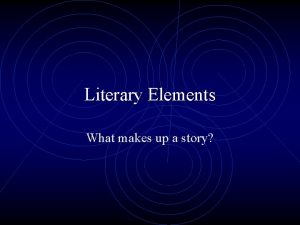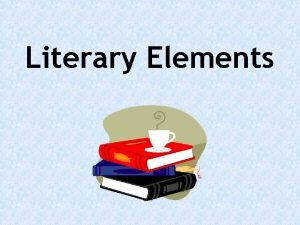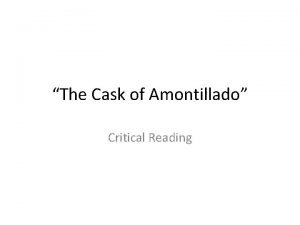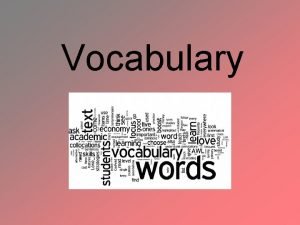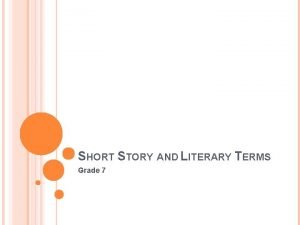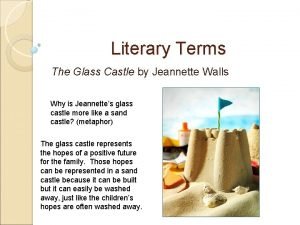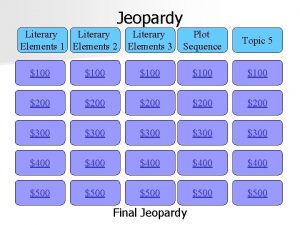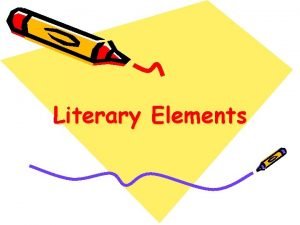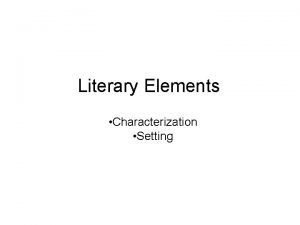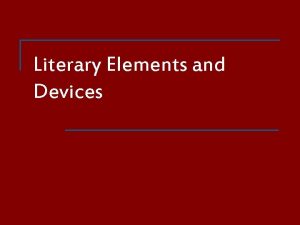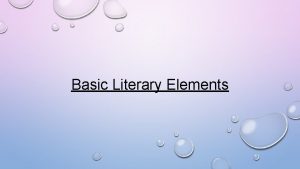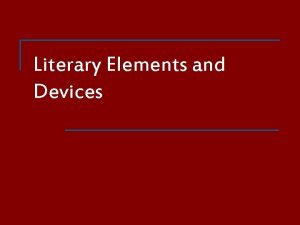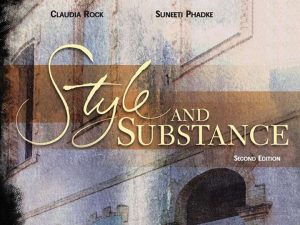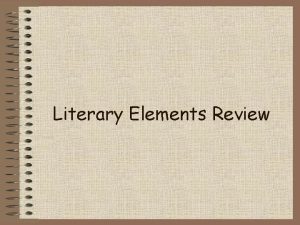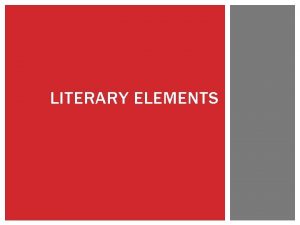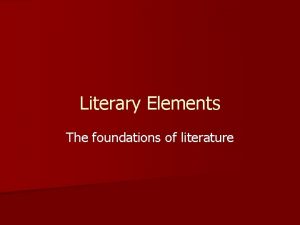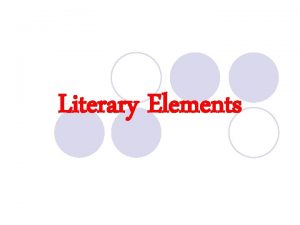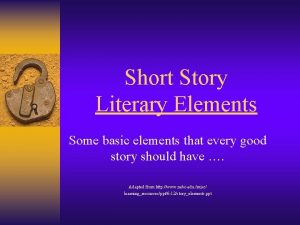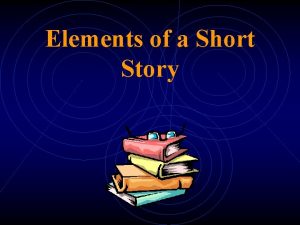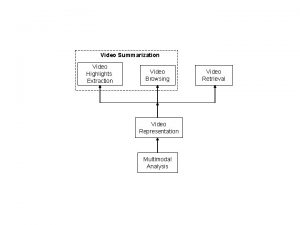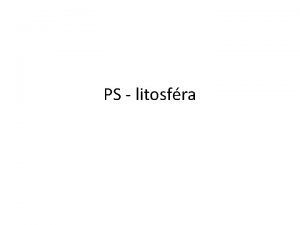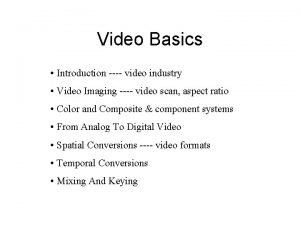Literary Elements What makes up a story Video























- Slides: 23

Literary Elements What makes up a story?

Video Recap • . . DocumentsFlocabulary - Five Things (Elements of a Short Story). 3 gp

What do you know? • You have 3 minutes to complete the plot diagram.

Story Grammar ØSetting ØCharacters ØPlot ØClimax ØTheme ØResolution ØDenouement

Setting Time and place are where the action occurs Details that describe: ü Furniture ü Scenery ü Customs ü Transportation ü Clothing ü Dialects ü Weather ü Time of day ü Time of year

Elements of a Setting

The Functions of a Setting Ø To create a mood or atmosphere Ø To show a reader a different way of life Ø To make action seem more real Ø To be the source of conflict or struggle Ø To symbolize an idea We left the home place behind, mile by slow mile, heading for the mountains, across the prairie where the wind blew forever. At first there were four of us with one horse wagon and its skimpy load. Pa and I walked, because I was a big boy of eleven. My two little sisters romped and trotted until they got tired and had to be boosted up to the wagon bed. That was no covered Conestoga, like Pa’s folks came West in, but just an old farm wagon, drawn by one weary horse, creaking and rumbling westward to the mountains, toward the little woods town where Pa thought he had an old uncle who owned a little two-bit sawmill. Taken from “The Day the Sun Came Out” by D. Johnson

Types of Characters ØDynamic character ØStatic characters ØMinor characters ØRound characters ØFlat characters

Character • Flat character- This type of character is not well- developed; NOT the main character • Round Character- This type of character CHANGE through out the story

• Static Character- This character stays the same through out the story. (supporting character) • Dynamic Character- This is the MAIN character. He/She has a lively personality and traits are well developed.

Characterization ØA writer reveals what a character is like and how the character changes throughout the story. ØTwo primary methods of characterization: üDirect- writer tells what the character is like üIndirect- writer shows what a character is like by describing what the character looks like, by telling what the character says and does, and by what other characters say about and do in response to the character.

Direct Characterization …And I don’t play the dozens or believe in standing around with somebody in my face doing a lot of talking. I much rather just knock you down and take my chances even if I’m a little girl with skinny arms and a squeaky voice, which is how I got the name Squeaky. From “Raymond’s Run” by T. Bambara

Indirect Characterization The old man bowed to all of us in the room. Then he removed his hat and gloves, slowly and carefully. Chaplin once did that in a picture, in a bank--he was the janitor. From “Gentleman of Rio en Medio” by J. Sedillo

Elements of Character

Plot is what happens and how it happens in a narrative. A narrative is any work that tells a story, such as a short story, a novel, a drama, or a narrative poem.

Parts of a Plot ØExposition- the introduction of the story ØRising Action – event that gives rise to conflict. ØClimax- highest point of interest or suspense of story ØFalling action- a series of events that leads to the resolution. ØResolution- when conflict ends

Diagram of Plot Inciting incident/ Opening situation ling Fal on i Act Exposition De Ris velop ing me Ac nt/ tio n Climax Resolution

Conflicts • Man vs. Man- a struggle between to people. • Man vs. Self (internal)- a struggle with self. It could be physically, psychological, or emotional. • Man vs. Nature- a struggle with animals or weather

Conflict • Man vs. Fate- a struggle that occurs when a person is trying to change destiny or an outcome. • Man vs. Society- a struggle when a person has a problem with rules and/or government.

Special Techniques of Plot ØSuspense- excitement or tension ØForeshadowing- hint or clue about what will happen in story ØFlashback- interrupts the normal sequence of events to tell about something that happened in the past ØSurprise Ending- conclusion that reader does not expect

Conflict ØConflict is a struggle between opposing forces ØEvery plot must contain some kind of conflict ØStories can have more than one conflict ØConflicts can be external or internal üExternal conflict- outside force may be person, group, animal, nature, or a nonhuman obstacle üInternal conflict- takes place in a character’s mind

Theme ØA central message, concern, or insight into life expressed through a literary work ØCan be expressed by one or two sentence statement about human beings or about life ØMay be stated directly or implied ØInterpretation uncovers theme

Example of Theme “Every man needs to feel allegiance to his native country, whether he always appreciates that country or not. ” From “A Man Without a Country” by Edward Hale pg. 185 in Prentice Hall Literature book
 Elements of a short story video
Elements of a short story video Literary devices vs literary elements
Literary devices vs literary elements Cinderella plot diagram
Cinderella plot diagram Narrative story elements
Narrative story elements Video yandex ru
Video yandex ru Yahoo search video
Yahoo search video Httptw
Httptw The frame size of a video refers to the video’s
The frame size of a video refers to the video’s Main problem in cinderella
Main problem in cinderella The cask of amontillado critical thinking questions
The cask of amontillado critical thinking questions Points of view in writing
Points of view in writing Theme of cinderella story
Theme of cinderella story Characters of folktales
Characters of folktales Elements of a music video
Elements of a music video What does a narrative designer do
What does a narrative designer do Literary elements jeopardy
Literary elements jeopardy Literary elements character
Literary elements character To kill a mockingbird literary devices
To kill a mockingbird literary devices Literary elements in the taming of the shrew
Literary elements in the taming of the shrew The adventures of huckleberry finn themes
The adventures of huckleberry finn themes Short story with characters, setting and plot
Short story with characters, setting and plot Glass castle literary devices
Glass castle literary devices Beowulf elements of the story
Beowulf elements of the story Literary elements in the lottery by shirley jackson
Literary elements in the lottery by shirley jackson
